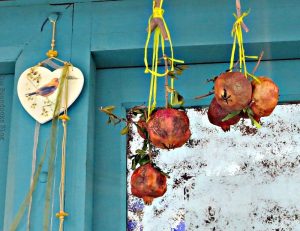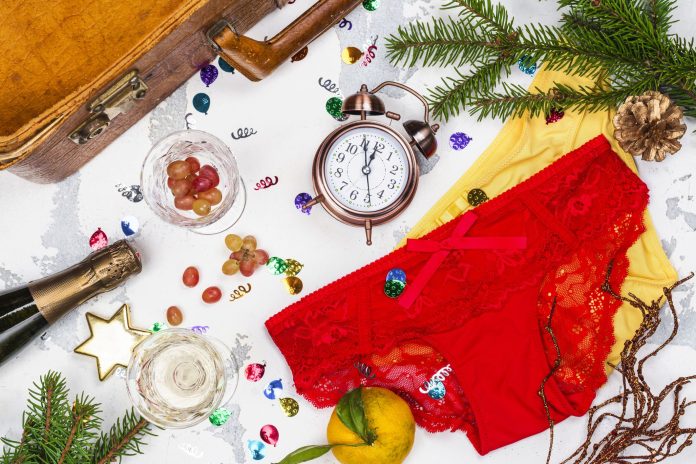Although much of the world festively rings in the new year each December 31, we don’t all celebrate the same way.
In the United States, the ball drops at Times Square, you share a kiss with a loved one at the stroke of midnight, and countless amounts of fireworks.
Elsewhere around the world, traditions can include everything from giving your house a thorough cleaning to cracking open a fresh pomegranate, as seen in the following narrations:

Various countries: Eating lucky foods
Throughout the world, New Year’s Eve is celebrated with a meal in the company of friends and family. In some places, this means eating specific “lucky” foods. In Spain, Portugal, and much of Latin America (such as Colombia), for example, it’s 12 grapes or raisins and in Italy, 12 spoonfuls of lentils—one with each of the 12 chimes of the clock at midnight.
The French usher in the best New Year with a stack of pancakes. Germans prefer marzipan shaped into a pig for luck, whereas in the Netherlands, people eat doughnuts and ring-shaped foods.
Estonians feast as many as 7, 9, or even 12 times on New Year’s Eve, as they believe for each meal consumed, the person gains the strength of that many men the following year.
Across the U.S. South, communities dig into collard greens and black-eyed peas for luck and prosperity on New Year’s Day.
Fun fact: Collard greens are chosen for their color—the green symbolizes money.
Estonians feast as many as 12 times on New Year’s Eve, as they believe for each meal consumed, the person gains the strength of that many men the following year

 Philippines: Wearing polka dots and eating round fruits
Philippines: Wearing polka dots and eating round fruits
To ensure a happy new year, the Filipino community believes that wearing round shapes (such as polka dots!) promotes prosperity and good luck. Additionally, it’s common eating round fruits —like oranges, watermelon, longan, grapes, and pomelos — considered fortuitous as well.

Brazil: Wearing white while jumping into the ocean
Wearing white on New Year’s Eve has long been a tradition with roots in Africa. In Brazil, the Festa de Lemanjá takes place on this night to celebrate the goddess of the sea (Lemanjá).
The culmination of the event is when everyone—dressed in white—runs into the water right at midnight to jump over seven waves. Each wave and jump signifies a different request the swimmer is making to a different orixá, or god.

Mexico: Walking around with an empty suitcase
In Mexico, there’s one tradition people participate in on New Year’s Eve to help ring in a year filled with travel and new experiences. In several Latin American countries, people will walk around with an empty suitcase or set it in the middle of a room and stroll around it. Others go further and take a full lap around the block with their empty luggage.

Cuba: Throwing a bucket of water out the front door
In Cuba, people symbolically gather all of the bad spirits and negative energy from the past 365 days and toss them right out the front door. It’s not uncommon to see buckets full of dirty water flying out of homes during the countdown to midnight.

Greece: Hanging and smashing pomegranates
Podariko, a Greek custom that roughly translates to “good foot,” aims to bring luck at the start of the year. Before the holiday, households will hang pomegranates, thought to be a sign of luck, prosperity, and fertility, from their door.
Then, on New Year’s Eve just before midnight, everyone will shut off the lights and leave the house so they can send a lucky individual to be the first to reenter the house, right foot first. When done correctly, it brings the family good fortune for the year.
Afterward, a second person will take the pomegranate in their right hand and smash it against the door to see just how much luck—the more juicy seeds that spill out, the more luck the new year will bring.

Germany: Melting lead to divine the future
In much of German-speaking Europe, as well as Finland, Bulgaria, Czechia, and Türkiye, it’s customary to heat small pieces of lead, then cast them in cold water and make a prediction for the new year based on the shapes that form.
For example, if a ball forms, luck will roll your way. These days, kits throughout German-speaking countries include tin (rather than lead) figurines to melt.
Russia: 12 seconds of silence before midnight
Russians say thank you to the past year by remembering its most important events during the hours leading up to midnight, and they use 12 seconds of silence before the stroke of midnight to make wishes.
Spain: Searching for the man with many noses
In the Catalonia region of northern Spain, a special character appears on the last day of the year. L’home dels nassos, or the man with many noses, has as many noses as there are days left in the year—and he grants wishes, if you can find him. According to this Spanish tradition, children are encouraged to look for him, rarely realizing that on the last day of the year, he only has one nose left and is, therefore, hard to spot.
Denmark: Jumping into the new year—literally
At midnight, Danes will jump off a chair or sofa—literally jumping into the new year. It’s seen as good luck if you do and bad luck if you don’t.

Ireland: Setting an extra place at the table
The Irish have several New Year’s traditions, such as banging the outside walls of their houses with bread to keep away bad luck and evil spirits and starting the year with a spotless, freshly cleaned home. But one of the most well-known is setting an additional plate at the dinner table for any loved ones lost in the prior year.

Italy and Spain: Wearing red underwear
Italians and Spaniards both wear red underwear for luck. However, Spaniards insist the underwear must also be new to be lucky. Italians, however, take things a step farther: They often throw old items out the window to symbolize the coming of new things with the New Year.
Japan: Visiting a temple for lucky charms
Japan’s New Year’s traditions have a wholesome focus. Shōgatsu (New Year) is usually celebrated with a visit to the local temple to exchange last year’s lucky charms (omamori) for new ones. Afterward, people will feast on traditional New Year’s foods, such as prawns (believed to bring a long life) and herring roe (to boost fertility).
Source: AFAR


